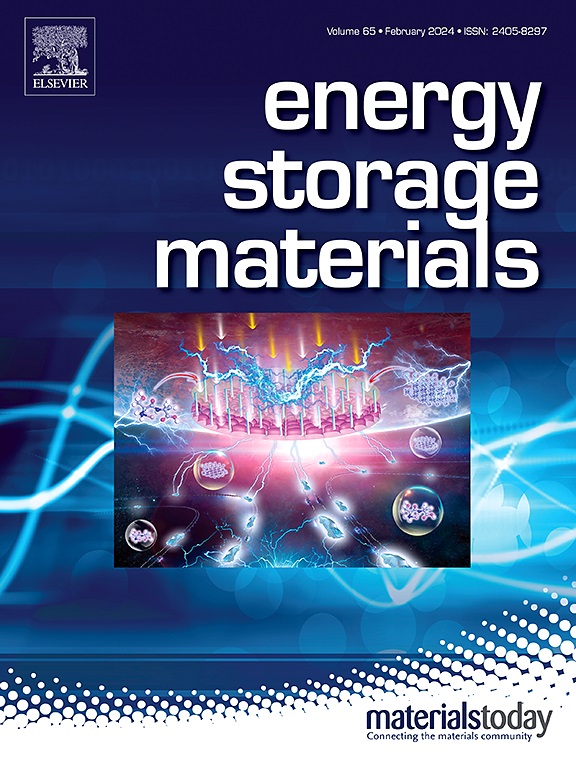基于非线性导波准静态分量的NCM锂离子电池电荷和正极材料状态映射的原位研究
IF 20.2
1区 材料科学
Q1 CHEMISTRY, PHYSICAL
引用次数: 0
摘要
锂离子电池(lib)已成为可再生能源系统的主要储能技术,需要对充电状态(SOC)和电极健康参数进行精确监测,以维持系统安全和确保运行可靠性。目前,超声导波技术能够快速、无损、灵敏地监测lib,但由于声波方向性和信号可解释性欠佳,其实施面临挑战。为了克服这些限制,本研究提出了一种结合非线性导波准静态分量(QSC-NGW)的创新方法。通过系统提取镍钴锰氧化物锂离子电池(NCM-LIBs)循环过程中的QSC-NGW信号,进行了全面的时频域分析,建立了波形特征与阴极微观结构演变之间的相关性,并通过扫描电镜(SEM)、拉曼光谱(RS)和原子力显微镜(AFM)等原位表征方法进行了验证。关键发现揭示了QSC-NGW信号时序与SOC之间的线性相关,而幅度变化定量反映了阴极相晶格转变。值得注意的是,与传统的线性导波方法相比,QSC-NGW方法具有更高的可靠性和测量精度,无需预先输入结构参数。这种双功能技术不仅可以实现实时SOC监测,还可以破译电极退化机制,从而为下一代电池诊断和健康管理建立物理信息框架。本文章由计算机程序翻译,如有差异,请以英文原文为准。


Mapping of state of charge and cathode material in NCM Li-ion batteries: an in-situ study based on the quasi-static component of nonlinear guided wave
Lithium-ion batteries (LIBs) have emerged as a dominant energy storage technology for renewable energy systems, necessitating precise monitoring of both state of charge (SOC) and electrode health parameters to maintain system safety and ensure operational reliability. Currently, ultrasonic guided wave technology enables rapid, non-destructive, and sensitive monitoring of LIBs, yet its implementation faces challenges due to suboptimal acoustic directionality and signal interpretability. To overcome these limitations, this research proposes an innovative methodology incorporating quasi-static components of nonlinear guided waves (QSC![]() NGW). Through systematic extraction of QSC
NGW). Through systematic extraction of QSC![]() NGW signals during cycling of nickel cobalt manganese oxide Li-ion batteries (NCM-LIBs), we conducted comprehensive time-frequency domain analyze and established correlations between waveform features and cathode microstructural evolution, which were verified through in-situ characterization method such as scanning electron microscopy (SEM), Raman spectroscopy (RS), and atomic force microscopy (AFM). Key findings reveal a linear correlation between QSC
NGW signals during cycling of nickel cobalt manganese oxide Li-ion batteries (NCM-LIBs), we conducted comprehensive time-frequency domain analyze and established correlations between waveform features and cathode microstructural evolution, which were verified through in-situ characterization method such as scanning electron microscopy (SEM), Raman spectroscopy (RS), and atomic force microscopy (AFM). Key findings reveal a linear correlation between QSC![]() NGW signal timing and SOC, while magnitude variations quantitatively mirror cathode phase lattice transitions. Notably, the QSC
NGW signal timing and SOC, while magnitude variations quantitatively mirror cathode phase lattice transitions. Notably, the QSC![]() NGW approach demonstrates enhanced reliability and measurement accuracy compared to conventional linear guided wave methods, eliminating the need for prior structural parameter inputs. This dual-functional technique not only facilitates real-time SOC monitoring but also deciphers electrode degradation mechanisms, thereby establishing a physics-informed framework for next-generation battery diagnostics and health management.
NGW approach demonstrates enhanced reliability and measurement accuracy compared to conventional linear guided wave methods, eliminating the need for prior structural parameter inputs. This dual-functional technique not only facilitates real-time SOC monitoring but also deciphers electrode degradation mechanisms, thereby establishing a physics-informed framework for next-generation battery diagnostics and health management.
求助全文
通过发布文献求助,成功后即可免费获取论文全文。
去求助
来源期刊

Energy Storage Materials
Materials Science-General Materials Science
CiteScore
33.00
自引率
5.90%
发文量
652
审稿时长
27 days
期刊介绍:
Energy Storage Materials is a global interdisciplinary journal dedicated to sharing scientific and technological advancements in materials and devices for advanced energy storage and related energy conversion, such as in metal-O2 batteries. The journal features comprehensive research articles, including full papers and short communications, as well as authoritative feature articles and reviews by leading experts in the field.
Energy Storage Materials covers a wide range of topics, including the synthesis, fabrication, structure, properties, performance, and technological applications of energy storage materials. Additionally, the journal explores strategies, policies, and developments in the field of energy storage materials and devices for sustainable energy.
Published papers are selected based on their scientific and technological significance, their ability to provide valuable new knowledge, and their relevance to the international research community.
 求助内容:
求助内容: 应助结果提醒方式:
应助结果提醒方式:


